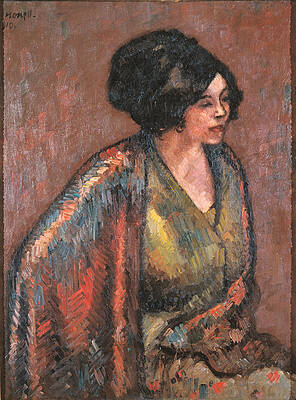Isidre Nonell
Bad Business
Pitcher Woman
Waiting
Gypsy Couple
Isidre Nonell i Monturiol (Catalan pronunciation: [iˈziðɾə nuˈneʎ], Spanish: Isidro Nonell y Monturiol) (November 30, 1872, Barcelona, Spain – February 21, 1911, Barcelona) a Catalonian painter and drawer belonging to post-impressionism known for his expressive portrayal of the socially marginalized of Barcelona society. (He is also said to belong to modernism and postmodernism.)
Life
Drawing Captaire a París,1897
Painting La Paloma, 1904
Painting Study, 1908
Painting still-life, 1910
Isidre Nonell was born in 1872 (not in 1873 as indicated by some biographers). His parents, Isidre Nonell i Torras de Arenys de Mar and Àngela Monturiol i Francàs of Barcelona, owned a small but prosperous factory of soup noodles. Together with his childhood friend, Joaquim Mir, with whom he attended the same school in the neighborhood of Sant Pere in the old part of town in Barcelona, he developed artistic ambitions at an early age.
His early teachers included Josep Mirabent, Gabriel Martínez Altés and Lluís Graner. From 1893 to 1895 he studied at the Escola de Belles Arts de Barcelona (Fine Arts School of Barcelona). He met Ricard Canals, Ramón Pichot, Juli Vallmitjana, Adrià Gual, and Joaquin Sunyer with whom he developed an interest in landscape painting, studying light. The study of sunlight and its effects on color were a main part of Impressionism, which was then active. They were called the "Saffron Group" for the warm tones they used, as well as the "Sant Martí Group" after the town they painted in.
In 1894, he began producing illustrations for La Vanguardia. He later drew for other periodicals, including L'Esquella de la Torratxa, Barcelona Cómica, Pèl & Ploma, and Forma (ca).
In 1896, Nonell went with Ricard Canals and Juli Vallmitjana to the spa town of Caldes de Boí in the Catalonian Pyrenees to work at the spa run by Vallmitjana's family. There, he saw a large number of people suffering from the illness of cretinism, which became a subject of his paintings.
In February 1897, he went to Paris with Ricard Canals. There he exhibited and shared a studio with Picasso. He returned to Barcelona in 1900. At the beginning of 1901, he made paintings of women, such as gypsy and working-class women, and still lifes. He exhibited in the Sala París in Barcelona twice, in 1902 and 1903. The reaction to his works of poor gypsy women was very hostile.
His work
The oil paintings show the influence of impressionism and pointillism expressed in a new way. Thick strokes layered one after another do not quite mix colors in the eye, leaving a directness of emotion. His subjects, most often women, are the poor and marginalized people of society: poor women (often with children), gypsies, wounded soldiers repatriated from the Cuban war, and people suffering from cretinism.
Though, his magazine drawings were critical of society, his other works show a deep feeling for those who suffered. His frank portrayal of poverty earned him mostly criticism and rejection.
Bibliography
VV.AA.: Isidre Nonell (1972–1911), Editorial MNAC, Barcelona i Fundación Cultural Mapfre, Madrid 2000, ISBN 84-89455-37-6
VV.AA.: Isidre Nonell, Editorial Polígrafa, Barcelona 1996, ISBN 84-343-0817-7
Fontbona, Francesc, Nonell, Gent Nostra, Thor, Barcelona 1987.
Jardí, Enric: Nonell, Editorial Polígrafa, Barcelona 1984, ISBN 84-343-0412-0
----
Fine Art Prints | Greeting Cards | Phone Cases | Lifestyle | Face Masks | Men's , Women' Apparel | Home Decor | jigsaw puzzles | Notebooks | Tapestries | ...
----
Artist
A - B - C - D - E - F - G - H - I - J - K - L - M -
N - O - P - Q - R - S - T - U - V - W - X - Y - Z
Retrieved from "http://en.wikipedia.org/"
All text is available under the terms of the GNU Free Documentation License







